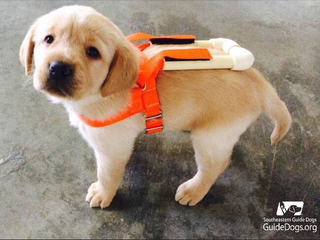The selection and training process for becoming a guide dog is extremely involved and begins from a very early age, when the dog is still just a puppy. In fact, it’s during these formative years that the decision whether or not to begin training is made.
Southeastern Guide Dogs in Palmetto, Florida is a non-profit organization that has been raising guide dogs since 1982. These highly skilled dogs are destined to become companions to the visually impaired and to veterans suffering from post-traumatic stress.

At Southeastern Guide Dogs, even play comes with a lesson or two. For example, these adorable labs are wearing a small, nylon harness while playing to get them used to the big harness they will be wearing someday, when they begin training with a handler.
“From the time they are born until they are matched with their forever handlers, our puppies soak up a reference library of experiences, sights and sounds that will help them fulfill their potential,” says Ruth Lando, a representative for Southeastern Guide Dogs. “That includes getting them accustomed to wearing a harness that will someday provide a lifeline for someone who needs them.”

The organization breeds, raises, and trains Labradors, Golden Retrievers and their unique “Goldadors” (Lab-Golden mixes) for working dogs. At as little as six weeks old the puppies have already begun testing by wearing small harnesses and taking part in simple training exercises so handlers can determine where each pup will be placed.
The truth is that not all puppies are suited to be a guide dog. “We constantly assess our puppies as they grow, making certain that they have the health, strength, temperament and trainability to become guide dogs,” Lando explains. “If not, they may be ‘career changed’ into other roles.”
What other roles? Southeastern Guide Dogs trains puppies to fulfil a broad range of canine tasks. A few of the roles these puppies may grow up to fill include: emotional support or facility therapy dogs for veterans, companions to visually impaired children too young for a guide dog, or ambassador dogs giving comfort in hospitals and schools.
So, even if they don’t become a guide dog, these puppies are destined to change a life.
 However, those that do go on have a lot of learning ahead of them. At 10 weeks, the puppies go into the homes of volunteer puppy parents whose job for the next year is to teach that puppy common house rules (like potty training), as well as to continue socializing them and teaching them basic obedience commands.
However, those that do go on have a lot of learning ahead of them. At 10 weeks, the puppies go into the homes of volunteer puppy parents whose job for the next year is to teach that puppy common house rules (like potty training), as well as to continue socializing them and teaching them basic obedience commands.Then, at around 18 months of age, they return to the Southeastern campus to complete “Guide Dog University,” where they spend 6 months learning over 40 specialized commands. Finally, after graduating, the dog is matched with their handler who will then live and work alongside with them on the campus for 26 days. “It takes about two years, tens-of-thousands-of-dollars, and a village of trainers to create the extraordinary dogs that we provide at no cost to their recipients,” Lando concludes.
If you are interested in helping puppies like these grow up to give the gifts of freedom, independence and dignity to someone in need, you can donate here. Sources: iheartdogs.com, Southeastern Guide Dogs

